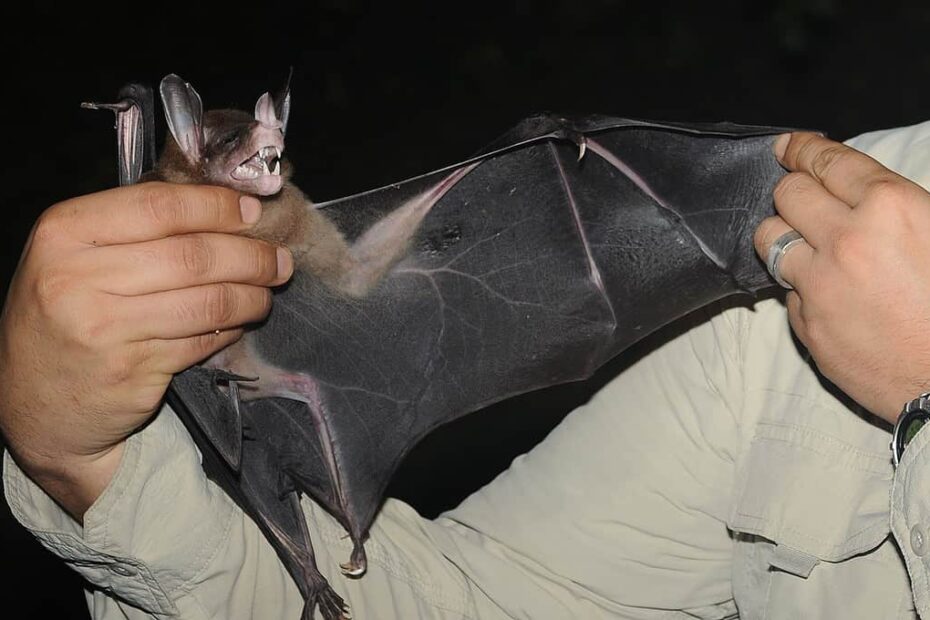Bats, often misunderstood and surrounded by myths, are fascinating creatures that play crucial roles in various ecosystems. Among these winged mammals, there’s one that holds a record — the largest bat in the world. Let’s embark on the journey to learn more about this remarkable species.
Which is the largest bat in the world?
The Title Holder: The Giant Golden-Crowned Flying Fox
The largest bat in the world, by wingspan, is the giant golden-crowned flying fox (Acerodon jubatus). This species, found in the Philippines, can boast a wingspan of up to 5.6 feet (1.7 meters). That’s about as wide as an average human is tall!
Largest Bat In The World Habitat
The giant golden-crowned flying fox resides in the forests of the Philippines. It’s a nocturnal creature, spending its days in large colonies in the treetops and setting out at night to feed. Unlike the common perception of bats as cave dwellers, these bats prefer the canopy of the forest, which provides both shelter and a base for their nightly forays.
What is the Largest Bat In The World Diet?
Giant Golden-Crowned flying fox is A Fruit Lover
Contrary to the eerie, blood-sucking image often associated with bats, the largest bat in the world is a fruit-eater. Its diet mainly consists of figs, along with other types of fruit. This dietary habit makes it an important seed disperser in its ecosystem, helping to maintain forest health and diversity.
Conservation Status: Under Threat
Unfortunately, the giant golden-crowned flying fox is currently facing the threat of extinction. Its conservation status, listed as endangered, is primarily due to deforestation and hunting. These bats are hunted for food and affected by the loss of their natural habitat, leading to a decline in their population.
Largest Bat In The World Physical Characteristics
Apart from its impressive wingspan, the giant golden-crowned flying fox has other distinctive features. It has a long snout, similar to that of a canine, and large eyes, giving it a unique appearance among bats. Its fur is dark brown to black, with a golden-brown patch on its head, which gives it its name.
The Role in the Ecosystem
The ecological role of the largest bat in the world cannot be overstated. As a frugivore, it plays a vital part in seed dispersal, which is crucial for the regeneration of forests. Its presence indicates the health of its habitat, making it a key species in conservation efforts.
Largest Bat In The World Misconceptions
Bats, including the giant golden-crowned flying fox, often suffer from a negative public image. Myths and fear, largely unfounded, surround these creatures. Educating people about the importance of bats in the ecosystem and their generally harmless nature is essential in changing these perceptions.
Ongoing research and study are critical in understanding and conserving the largest bat in the world. Efforts by conservationists and scientists aim to protect these bats, but challenges such as habitat loss and human-wildlife conflict continue to pose significant threats.
What is largest bat in the world height?
In the fascinating world of bats, size varies greatly from the tiny bumblebee bat to the gigantic ones that seem straight out of a fantasy novel. When it comes to identifying the largest bat in the world, the metric of height becomes a point of intrigue.
Understanding Bat Size Metrics
Before delving into which is the largest bat, it’s essential to understand how bat size is measured. Typically, bats are measured by their wingspan – the length from one wingtip to the other when the wings are fully extended. However, the height of a bat – measured from head to toe when in a resting position – offers a different perspective on their size.
The largest bat in the world by wingspan, giant golden-crowned flying fox (Acerodon jubatus) has a wingspan reaching up to 5.6 feet (1.7 meters). But when it comes to height, the measurement is a bit more complex due to their posture and the way they roost.
Measuring the Height of Acerodon Jubatus
The Acerodon jubatus, when resting, hangs upside down with its wings wrapped around its body. Measuring the height from head to toe in this position can be challenging. However, when stretched out, these bats can measure up to 11 inches (28 cm) from head to toe, making them one of the tallest bat species when considering body size alone.
Acerodon Jubatus Comparison with Other Large Bats
While the Acerodon jubatus stands out for its wingspan, other bat species are notable for their body size. For example, the Malayan flying fox (Pteropus vampyrus) can have a similar height, with large individuals measuring close to the Acerodon jubatus in body length.
The Role of Acerodon Jubatus in the Ecosystem
Aside from its size, the Acerodon jubatus plays a crucial role in its ecosystem. As a frugivore, it aids in seed dispersal and maintaining the health of tropical forests. Understanding its physical characteristics, including its height, contributes to a better appreciation of its ecological importance.
While the giant golden-crowned flying fox, Acerodon jubatus, is recognized as the largest bat in the world by wingspan, its height also places it among the largest. These nocturnal creatures, with their significant size and ecological role, remind us of the diversity and wonder of nature.
Featured image courtesy: www.a-z-animals.com
